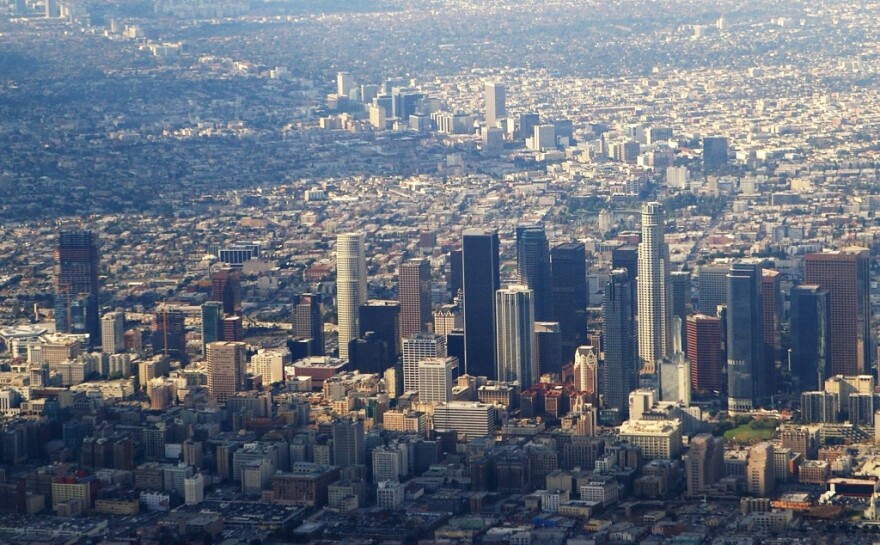With our free press under threat and federal funding for public media gone, your support matters more than ever. Help keep the LAist newsroom strong, become a monthly member or increase your support today.
Researchers give LA addresses for concrete buildings that could be at risk in a quake

In what some consider an important step toward saving thousands of lives during an earthquake, University of California researchers Tuesday handed over to LA city officials the addresses of hundreds of older, concrete buildings that could be at risk of collapse.
UC researchers have been surveying so-called “nonductile” concrete buildings constructed before stricter building codes were put in place in 1976. The researchers have stressed the survey doesn’t identify buildings that are specifically at risk of collapse, but rather the types of buildings that could be vulnerable.
“The study did not determine whether any specific building represents a greater collapse hazard than other buildings,” the researchers wrote in an introductory summary. “Such determination would require a detailed site investigation and structural analysis by an engineer.”
Mayor Eric Garcetti said the city intends to review the list closely as part of efforts to improve earthquake safety. US Geological Society seismologist Dr. Lucy Jones will lead the effort.
“I’ve have brought on Dr. Lucy Jones to take a yearlong process to take a look at precisely that.”
Jones said it’s likely that only a fraction of structures on the list would collapse during an earthquake.
“I think we need to not make too much of the list," Jones said.
Researchers announced on Friday they planned to make public a database of 1,454 concrete structures in Los Angeles, including apartment buildings, schools, offices, churches, shopping malls, hospitals and hotels. The publicly available list identifies the buildings only by broad longitude and latitude coordinates.
Engineers have estimated that around ten percent of these types of buildings could crumble during an earthquake.
The list is drawn from an inventory completed in 2011 and based on available public records.
Based on an examination of latitude and longitude points for each of the 1,454 buildings, KPCC could not plot extact locations of the buildings. As such we used data from the L.A. Times neighborhood mapping project to determine geographic boundaries for neighborhoods in Los Angeles. We then plotted the generalized locations of the buildings on the list.
GIS software allowed us to determine which points appeared within which geographic boundaries.
The results showed that more than 400 buildings are located Downtown (402); more than 100 in Hollywood; 100 in Koreatown; more than 60 in Westlake and just over 40 in East Hollywood.
Among the buildings on the list released Tuesday, just under half (717 buildings) are designated as having an earthquake design level of "Pre Code." According to Federal Emergency Management Agency's Hazus software package, developed to estimate loss of life and infrastructure following a natural disaster, this means they were built before seismic codes were required for building design.
Of these 717, 130 are classified by Hazus as being "Retail Trade" and 117 are classified as "Light Industrial."
The next task for the city is to ask property owners if they’ve upgraded their buildings or know of structural features that make them safe – for example the use of solid concrete walls around elevator shafts or concrete columns reinforced with spiraling steel. Getting that information won’t be easy because the buildings were constructed before digital databases.
“So we are talking about paper records," Jones said. "How to sift through all of that an understand it is a big issue.”
City resources are scare. The LA Department of Building and Safety "has no program or funding in place for inspection of these buildings,” said Chief Building Inspector Zamperini.
Many – perhaps hundreds – will require physical inspection, said Jones.
“There are a lot of ways in which that’s being proposed to happen. One of the things might be to turn to engineering students, potentially," she said.
The release of the list is an important step toward making the city safer during earthquakes, said John Wallace, a professor at UCLA’s Department of Civil and Environmental Engineering.
“I think it is a significant moment," he said.
Its significant not just because of the list, but because there’s been 20 years of research into how to make concrete buildings safer at lower costs.
"So we are in a much better place to do the upgrades now than we were 20 years ago when seismic retrofitting of buildings and bridges was a fairly new research area," he said.
Wallace says its imperative city officials take this opportunity to figure out which older concrete buildings in LA need reinforcing for the inevitable “Big One” that will hit the city.
“The number of deaths that could occur in some of these buildings is going to be eye raising" he warned. The toll could run into the thousands, Wallace says.
Also found in the data released:
- 202 of the buildings on the list can be classified as residential using FEMA's Hazus software designations.
- 86 are classified as multi-unit dwellings with 50 or more housing units. 52 of these were built in 1930 or earlier. 24 are 10 or more stories tall.
- 49 are classified as hotels or motels (temporary housing).
- 31 are classified as multi-unit dwellings with 20-49 housing units.
- 30 are classified as nursing homes.








